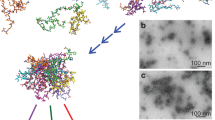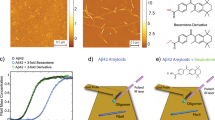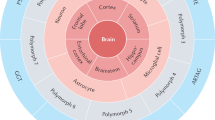Abstract
Amyloidogenic peptides and proteins play a crucial role in a variety of neurodegenerative disorders such as Alzheimer's and Parkinson's disease. These proteins undergo a spontaneous transition from a soluble, often partially folded form, into insoluble amyloid fibrils that are rich in β-sheets. Increasing evidence suggests that highly dynamic, polydisperse folding intermediates, which occur during fibril formation, are the toxic species in the amyloid-related diseases. Traditional condensed-phase methods are of limited use for characterizing these states because they typically only provide ensemble averages rather than information about individual oligomers. Here we report the first direct secondary-structure analysis of individual amyloid intermediates using a combination of ion mobility spectrometry–mass spectrometry and gas-phase infrared spectroscopy. Our data reveal that oligomers of the fibril-forming peptide segments VEALYL and YVEALL, which consist of 4–9 peptide strands, can contain a significant amount of β-sheet. In addition, our data show that the more-extended variants of each oligomer generally exhibit increased β-sheet content.
This is a preview of subscription content, access via your institution
Access options
Subscribe to this journal
Receive 12 print issues and online access
$259.00 per year
only $21.58 per issue
Buy this article
- Purchase on Springer Link
- Instant access to full article PDF
Prices may be subject to local taxes which are calculated during checkout




Similar content being viewed by others

References
Caughey, B. & Lansbury, P. T. Protofibrils, pores, fibrils, and neurodegeneration: separating the responsible protein aggregates from the innocent bystanders. Annu. Rev. Neurosci. 26, 267–298 (2003).
Dobson, C. M. Protein folding and misfolding. Nature 426, 884–890 (2003).
Selkoe, D. J. Folding proteins in fatal ways. Nature 426, 900–904 (2003).
Walsh, D. M. et al. Naturally secreted oligomers of amyloid β protein potently inhibit hippocampal long-term potentiation in vivo. Nature 416, 535–539 (2002).
Goedert, M. & Spillantini, M. G. A century of Alzheimer's disease. Science 314, 777–781 (2006).
Lesné, S. et al. A specific amyloid-β protein assembly in the brain impairs memory. Nature 440, 352–357 (2006).
Winner, B. et al. In vivo demonstration that α-synuclein oligomers are toxic. Proc. Natl Acad. Sci. USA 108, 4194–4199 (2011).
Lin, C.-Y. et al. Toxic human islet amyloid polypeptide (h-IAPP) oligomers are intracellular, and vaccination to induce anti-toxic oligomer antibodies does not prevent h-IAPP-induced β-cell apoptosis in h-IAPP transgenic mice. Diabetes 56, 1324–1332 (2007).
Gurlo, T. et al. Evidence for proteotoxicity in β cells in type 2 diabetes: toxic islet amyloid polypeptide oligomers form intracellularly in the secretory pathway. Am. J. Pathol. 176, 861–869 (2010).
Chiti, F. & Dobson, C. M. Protein misfolding, functional amyloid, and human disease. Annu. Rev. Biochem. 75, 333–366 (2006).
Ivanova, M. I., Sievers, S. A., Sawaya, M. R., Wall, J. S. & Eisenberg, D. Molecular basis for insulin fibril assembly. Proc. Natl Acad. Sci. USA 106, 18990–18995 (2009).
Nelson, R. et al. Structure of the cross-β spine of amyloid-like fibrils. Nature 435, 773–778 (2005).
Stromer, T. & Serpell, L. C. Structure and morphology of the Alzheimer's amyloid fibril. Microsc. Res. Tech. 67, 210–217 (2005).
Sawaya, M. R. et al. Atomic structures of amyloid cross-β spines reveal varied steric zippers. Nature 447, 453–457 (2007).
Matthes, D. et al. Spontaneous aggregation of the insulin-derived steric zipper peptide VEALYL results in different aggregation forms with common features. J. Mol. Biol. 426, 362–376 (2014).
Cerf, E. et al. Antiparallel β-sheet: a signature structure of the oligomeric amyloid β-peptide. Biochem. J. 421, 415–423 (2009).
Celej, M. S. et al. Toxic prefibrillar α-synuclein amyloid oligomers adopt a distinctive antiparallel β-sheet structure. Biochem. J. 443, 719–726 (2012).
Buchanan, L. E. et al. Mechanism of IAPP amyloid fibril formation involves an intermediate with a transient β-sheet. Proc. Natl Acad. Sci. USA 110, 19285–19290 (2013).
Bernstein, S. L. et al. Amyloid-β protein oligomerization and the importance of tetramers and dodecamers in the aetiology of Alzheimer's disease. Nat. Chem. 1, 326–331 (2009).
Bleiholder, C., Dupuis, N. F., Wyttenbach, T. & Bowers, M. T. Ion mobility-mass spectrometry reveals a conformational conversion from random assembly to β-sheet in amyloid fibril formation. Nat. Chem. 3, 172–177 (2011).
Dupuis, N. F., Wu, C., Shea, J.-E. & Bowers, M. T. The amyloid formation mechanism in human IAPP: dimers have β-strand monomer–monomer interfaces. J. Am. Chem. Soc. 133, 7240–7243 (2011).
Bleiholder, C. et al. Ion mobility spectrometry reveals the mechanism of amyloid formation of Aβ(25–35) and its modulation by inhibitors at the molecular level: epigallocatechin gallate and scyllo-inositol. J. Am. Chem. Soc. 135, 16926–16937 (2013).
Do, T. D. et al. Effects of pH and charge state on peptide assembly: the YVIFL model system. J. Phys. Chem. B 117, 10759–10768 (2013).
Do, T. D. et al. Interactions between amyloid-β and tau fragments promote aberrant aggregates: implications for amyloid toxicity. J. Phys. Chem. B 118, 11220–11230 (2014).
Do, T. D. et al. Factors that drive peptide assembly from native to amyloid structures: experimental and theoretical analysis of [leu-5]-enkephalin mutants. J. Phys. Chem. B 118, 7247–7256 (2014).
Young, L. M., Cao, P., Raleigh, D. P., Ashcroft, A. E. & Radford, S. E. Ion mobility spectrometry–mass spectrometry defines the oligomeric intermediates in amylin amyloid formation and the mode of action of inhibitors. J. Am. Chem. Soc. 136, 660–670 (2014).
Young, L. M. et al. Screening and classifying small-molecule inhibitors of amyloid formation using ion mobility spectrometry–mass spectrometry. Nat. Chem. 7, 73–81 (2015).
Zheng, X. Y. et al. Amyloid β-protein assembly: the effect of molecular tweezers CLR01 and CLR03. J. Phys. Chem. B 119, 4831–4841 (2015).
Jackson, M. & Mantsch, H. H. The use and misuse of FTIR spectroscopy in the determination of protein structure. Crit. Rev. Biochem. Mol. Biol. 30, 95–120 (1995).
Barth, A. Infrared spectroscopy of proteins. Biochim. Biophys. Acta 1767, 1073–1101 (2007).
Oomens, J., Sartakov, B. G., Meijer, G. & von Helden, G. Gas-phase infrared multiple photon dissociation spectroscopy of mass-selected molecular ions. Int. J. Mass Spectrom. 254, 1–19 (2006).
Papadopoulos, G., Svendsen, A., Boyarkin, O. V. & Rizzo, T. R. Spectroscopy of mobility-selected biomolecular ions. Faraday Discuss. 150, 243–255 (2010).
Knowles, T. P. J. et al. An analytical solution to the kinetics of breakable filament assembly. Science 326, 1533–1537 (2009).
Schöllkopf, W. et al. The new IR and THz FEL facility at the Fritz Haber Institute in Berlin, Advances in X-ray Free-Electron Lasers Instrumentation III (ed. Briedon, S.G.) (Proc. of SPIE Vol. 9512, SPIE, 2015).
Cai, S. & Singh, B. R. A distinct utility of the amide III infrared band for secondary structure estimation of aqueous protein solutions using partial least squares methods. Biochemistry 43, 2541–2549 (2004).
Bleiholder, C., Wyttenbach, T. & Bowers, M. T. A novel projection approximation algorithm for the fast and accurate computation of molecular collision cross sections. (I) Method. Int. J. Mass Spectrom. 308, 1–10 (2011).
Wyttenbach, T., Bleiholder, C. & Bowers, M. T. Factors contributing to the collision cross section of polyatomic ions in the kilodalton to gigadalton range: application to ion mobility measurements. Anal. Chem. 85, 2191–2199 (2013).
Marklund, E. G., Degiacomi, M. T., Baldwin, A. J. & Benesch, J. L. P. Collision cross sections for structural proteomics. Structure 23, 1–9 (2015).
Atherton, E. & Sheppard, R. C. Solid Phase Peptide Synthesis: A Practical Approach (Oxford Univ. Press, 1989).
Warnke, S., von Helden, G. & Pagel, K. Protein structure in the gas phase: the influence of side-chain microsolvation. J. Am. Chem. Soc. 135, 1177–1180 (2013).
Warnke, S., Baldauf, C., Bowers, M. T., Pagel, K. & von Helden, G. Photodissociation of conformer-selected ubiquitin ions reveals site-specific cis/trans isomerization of proline peptide bonds. J. Am. Chem. Soc. 136, 10308–10314 (2014).
Warnke, S. et al. Protomers of benzocaine: solvent and permittivity dependence. J. Am. Chem. Soc. 137, 4236–4242 (2015).
Kemper, P. R., Dupuis, N. F. & Bowers, M. T. A new, higher resolution, ion mobility mass spectrometer. Int. J. Mass Spectrom. 287, 46–57 (2009).
Acknowledgements
The authors thank S. Huhmann for the help during synthesis, L. Urner for fruitful discussion and R. Schlögl for proofreading the manuscript. B. Koksch and M. Villinger are gratefully acknowledged for providing the peptide synthesis facilities and EM infrastructure. M.T.B. acknowledges the Alexander von Humboldt-Foundation and the National Science Foundation for support under grant CHE-1301032.
Author information
Authors and Affiliations
Contributions
J.S., W.H., M.T.B., G.v.H. and K.P. conceived and designed the experiments; J.S., W.H. and S.W. performed the experiments: X.H., S.G. and W.S. supported the experiments; J.S. and W.H. analysed data; all the authors co-wrote the paper. J.S. and W.H. contributed equally to this work.
Corresponding authors
Ethics declarations
Competing interests
The authors declare no competing financial interests.
Supplementary information
Supplementary information
Supplementary information (PDF 1865 kb)
Rights and permissions
About this article
Cite this article
Seo, J., Hoffmann, W., Warnke, S. et al. An infrared spectroscopy approach to follow β-sheet formation in peptide amyloid assemblies. Nature Chem 9, 39–44 (2017). https://doi.org/10.1038/nchem.2615
Received:
Accepted:
Published:
Issue Date:
DOI: https://doi.org/10.1038/nchem.2615
This article is cited by
-
Highly selective adsorption of rhenium by amyloid-like protein material
Science China Technological Sciences (2023)
-
Bioinformatics methods for identification of amyloidogenic peptides show robustness to misannotated training data
Scientific Reports (2021)
-
Wie kleine Amyloid-β-Peptide zum großen Problem im Gehirn werden können
BIOspektrum (2021)
-
Emergence of low-symmetry foldamers from single monomers
Nature Chemistry (2020)
-
Mg-ion conducting triblock copolymer electrolyte based on poly(VdCl-co-AN-co-MMA) with magnesium nitrate
Ionics (2020)


